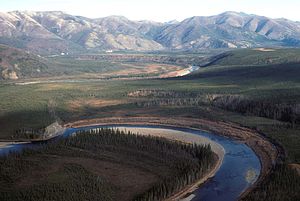Beaver Creek (Alaska)
| Beaver Creek | |
|
Beaver Creek in Yukon Flats
|
|
| Country | United States |
|---|---|
| State | Alaska |
| Census Area | Yukon–Koyukuk |
| Source | confluence of Champion and Bear creeks |
| - location | White Mountains National Recreation Area |
| - coordinates | 65°24′56″N 146°59′04″W / 65.41556°N 146.98444°W |
| Mouth | Yukon River |
| - location | south-southwest (downstream) of Beaver, Yukon Flats National Wildlife Refuge |
| - elevation | 335 ft (102 m) |
| - coordinates | 66°14′19″N 147°31′58″W / 66.23861°N 147.53278°WCoordinates: 66°14′19″N 147°31′58″W / 66.23861°N 147.53278°W |
| Length | 180 mi (290 km) |
Beaver Creek is a 180-mile (290 km) tributary of the Yukon River in the U.S. state of Alaska. The creek begins at the confluence of Champion and Bear creeks in the White Mountains National Recreation Area, about 50 miles (80 km) north of Fairbanks. From there it flows west around the southern end of the White Mountains, then northeast into the Yukon Flats National Wildlife Refuge, then west into the Yukon River downstream of Beaver.
In 1980, The Alaska National Interest Lands Conservation Act designated the upper 127 miles (204 km) of Beaver Creek as part of the National Wild and Scenic Rivers System. Most of this lies within the recreation area, but the last 16 miles (26 km) are in the wildlife refuge.
Beaver Creek flows from its headwaters through thick forest of white spruce and paper birch forests and tundra on the high slopes of the White Mountains, where limestone peaks reach 3,176 feet (968 m) on the creek's north and east side. The creek has plentiful gravel bars, and willows grow on its banks.
The lower portion of the creek follows very convoluted course through Yukon Flats, an area that contains thousands of lakes. Geographical features of these lowlands include sloughs and oxbow lakes. Beaver Creek is part of an active alluvial stream system in one of the most productive waterfowl breeding areas in North America and the most productive in Alaska.
...
Wikipedia


